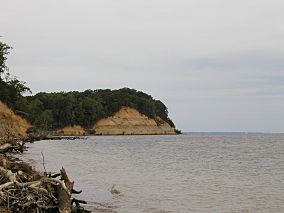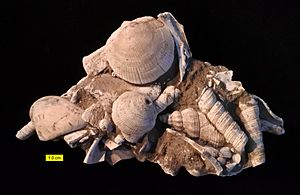Calvert Cliffs State Park facts for kids
Quick facts for kids Calvert Cliffs State Park |
|
|---|---|
|
IUCN Category III (Natural Monument)
|
|

The park's namesake cliffs
|
|
| Location | Calvert County, Maryland, United States |
| Nearest town | Lusby, Maryland |
| Area | 1,311 acres (5.31 km2) |
| Elevation | 112 ft (34 m) |
| Designation | Maryland state park |
| Established | 1960s |
| Administrator | Maryland Department of Natural Resources |
| Website | Calvert Cliffs State Park |
Calvert Cliffs State Park is a fun public park in Lusby, Calvert County, Maryland. It protects a part of the famous Calvert Cliffs. These cliffs stretch for 24 miles along the eastern side of the Calvert Peninsula. They are on the west side of Chesapeake Bay. The park is very well known for the many fossils found on its shoreline. Most of these fossils are from the Middle Miocene time period.
Contents
Discovering Calvert Cliffs State Park
Calvert Cliffs State Park is a great place to explore nature. It is mostly covered by forests. You can also find wetlands and a small pond there. The park has many different kinds of plants and animals. Over 160 types of birds have been seen in the park.
What Can You Do at the Park?
- Hiking: The park has about 13 miles of marked trails. These trails are perfect for walking and exploring.
- Beach Access: A sandy beach is available for visitors. You can reach it by walking a 1.8-mile trail.
- Fossil Hunting: The beach is famous for finding fossils. You can look for ancient shark teeth and other treasures.
- Fishing: The small pond in the park is a good spot for fishing.
- Hunting: About 550 acres of the park are open for hunting. This includes upland game, turkey, and deer.
The Amazing History of the Cliffs
The Calvert Cliffs are very old. They were formed millions of years ago.
How Were the Cliffs Formed?
The cliffs are made of rock layers called the Calvert Formation. These rocks are actually sediment from an ancient ocean. This ocean covered the area about 19 to 14 million years ago. This was during the Miocene period. The Calvert Formation is found in Maryland and nearby Virginia.
You can also see rocks from the younger Choptank Formation and St. Marys Formations here. These layers are important for scientists. They help us learn about ancient climates. They also show us about a small mass extinction event. This event happened during the Middle Miocene. It is sometimes called the "Middle Miocene disruption."
Hunting for Fossils
The Calvert Formation is famous for its many fossil shark teeth. People who love to find rocks and fossils often look for teeth from huge sharks. These include Carcharocles and the famous megalodon. The megalodon is often considered part of the Carcharocles group.
You are allowed to collect fossils on the beach. However, you cannot go onto the cliffs themselves. This is because the cliffs can be dangerous due to erosion.
Many other amazing fossils have been found here:
- Ancient Whales: Fossils of an ancient baleen whale called Eobalaenoptera harrisoni were found. These are the oldest known members of their family.
- Prehistoric Birds: The oldest known merganser bird, Mergus miscellus, was found here. Also, very old fossils of a prehistoric loon (Gavia) were discovered. These are some of the oldest loon fossils in the world.
- Swordfish-like Creatures: Fossils of a swordfish-like animal called Eurhinodelphis longirostris have also been found.
In 2004, a hobbyist paleontologist found a Cephalotropis coronatus whale. This happened after a storm caused some cliff erosion. Parts of the whale, like its skull, are now on display. You can see them at the Calvert Marine Museum. Other items found with the whale included fish bones, shells, and shark teeth.
A Brief Look at the Park's Past
In 1612, explorer Captain John Smith mapped this area. He named the cliffs "Rickard's Cliffes" after his mother's family.
Many years later, in the 1960s, the state of Maryland started buying land for the park. They bought land from 1965 to 1968. Then, in 1969, money was set aside to build roads, parking areas, and other facilities for the park.
Nearby Industrial Sites
The Calvert Cliffs Nuclear Power Plant is located a short distance north of the park. Also, the Dominion Cove Point natural gas station can be seen offshore from the park beach.



